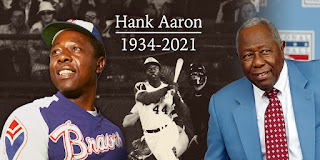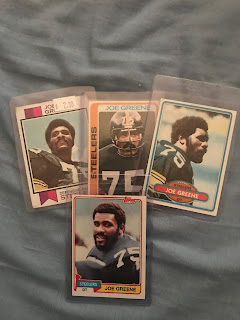I have one undeniable card
collecting truth.
I
will never own a Jackie Robinson card from his playing days.
Okay,
this isn’t set in stone.
And
it’s not undeniable.
But
it’s pretty damned close.
I
found myself perusing ComC the other day, as many of you might be doing right
now, or after you read this post. I was doing what card collectors do: I was buying
cards. My Henry Aaron post inspired me to actually begin building up my Aaron
collection. I found a 1972 Topps Aaron, whose card condition I could live with.
While on ComC I decided, for shits and giggles, to take a look at Jackie
Robinson cards.
That
was a quick trip.
For
the record, whenever I’m on ComC I choose two filters. I choose “ungraded” and “buy
now.” I don’t have any issues with people who choose to get cards graded. It’s
just not my style. Nor am I a fan of “gambling” so I tend to want to buy my
cards outright. I shouldn’t call buying cards on auction or bidding as being
gambling. A lot of collectors get cards they want affordably by doing that. I tend
to have a real Charlie Brown view of my life, and don’t view winning in most
cases as being an option.
With Jackie
Robinson cards from his playing days, it really didn’t matter how I filtered.
Graded/ungraded. Buy now/auction. I wasn’t going to be able to afford one
anyway. That ship has essentially sailed. The stuff I could remotely afford,
even I wouldn’t want to buy the card in that condition.
And my standards
aren’t too high.
A Clemente is a Clemente.
And a pipe dream is a pipe dream, right?
Still…
I
suppose I should answer as to why I’d want Jackie Robinson cards in my
collection. Or maybe the question is, why wouldn’t a collector want Jackie Robinson
cards in their collection? Jackie Robinson is baseball history personified. His
statistics, historical documents of the times. His cards of that era, the same.
This isn’t anything a baseball fan or a card collector doesn’t already know. Jackie
Robinson is a cultural hero. He’s a hero to baseball as well. The sport retired
his damned number! In a sport full of Ruths, Gehrigs, Aarons, Mays, and
Clemente, Jackie Robinson still stands heads and shoulders above them all.
Okay,
maybe Babe Ruth is debatable.
And
I can’t afford his cards either.
All
the same because of his stature and talent, it be cool to have cards from
Jackie Robinson’s playing days in my collection.
But
it’s not going to happen.
It’s
undeniable.
At
least right now it is.
Maybe
I’ll start playing the lottery today.
If
I want Jackie Robinson cards in my collection, I have to rely on cards like the one above.
Or
this.
One of only two Project 2020 cards that I bought.
I’ve
said, more times than you want to read, how much I like post-career playing
cards for players. I love seeing players like Henry Aaron, Jackie Robinson, or
Roberto Clemente in the designs from my youth. I also enjoy seeing today’s young
stars like Vlady Jr. or Yordan Alvarez on design from before their time. Their
great in sets like Heritage and even more so in sets like Archives, that blend
the past and present together on a number of designs.
I
even like seeing the old timers in Stadium Club.
Like American Badass Eddie Murray.
I
do with a few.
Mainly
Clemente, Willie Stargell and Henry Aaron.
I
won’t be adding this Will Clark card to my collection.
Will Clark already had a 1987 Topps card.
I do collect Jackie Robinson post-playing day cards, however. Or, if I don’t collect them, I at least keep all of the ones that I get as inserts in packs or in boxes, or I keep the doubles from sets like Stadium Club or Archives. The answer is obvious as to why. These cards are the closest I’m going to get to actual Jackie Robinson cards.
And,
yes, I do this for Babe Ruth too.
But
this isn’t a blog post about him.
Admittedly
my collection of Jackie Robinson cards is a modest one.
My latest Jackie
Yep, that’s almost everything.
I
even have some ephemera from when Jackie’s number was retired by Major League baseball.
I forgot there was a reprint of Jackie’s 1948 Leaf card inside.
I
guess I own me a Jackie Robinson “rookie” card.
July
12, 1997. That was when the Pirates officially retired Jackie Robinson’s number
42 in a pre-game ceremony in front of 44,000 fans. I didn’t attend this game,
though I attended a good many in 1997. My old man did and figured maybe the items
would be in good hands with me. I’ve held on to them for twenty-five years. The
game was wild too. Francisco Cordova and Ricardo Rincon threw a 10-inning no
hitter against the Astros, and won on a home run by Mark Smith.
The
1997 Pittsburgh Pirates were dubbed “The Freak Show.”
They
almost won the division with a 79-83 record.
1997
was the first season that I really got back into Pirates baseball after they
broke my heart in the 1992 NLCS.
I’d
spent from 1993-1997 pre-occupied with college and women.
I
was probably having women troubles on July 12, 1997, if memory serves me correctly.
But
this isn’t a blog post about that either.
Living
in Brooklyn, there’s a lot Dodgers history still around. You can visit the one
remaining wall to Ebbets Field at the Ebbets Field apartments. A number of
homes that players owned are still around. One owned by Duke Snider is in the
actual neighborhood where I live. The Mets jack Brooklyn Dodgers history
whenever they can. And Jackie Robinson, himself, is buried in the Cypress Hills
cemetery, here in Brooklyn. A long, long way from Pasedina.
So,
there is that aura that still surrounds him here in New York City.
During
the initial quarantine stretch of the never-ending pandemic, when baseball was
supposed to be happening, but wasn’t happening, I comforted myself by reading a
number of books on baseball and biographies on baseball players. One such book
was Arnold Rampersad’s excellent biography on Jackie Robinson.
Not only does Rampersad do an excellent job of showing what Jackie Robinson went through breaking into the Major Leagues as the first player of color, the book does a fine job of detailing Robinson’s post-playing life as well. Jackie spent more years as an executive for Chock Full O Nuts than he ever did with the Dodgers, and he had contact and connections with everyone from Dwight Eisenhower to Malcolm X.
The
Rampersad book pushed me deeper into Jackie territory and was the catalyst for
me beginning to pull his cards from my insert boxes, and to put them in a
proper player place in my PC. If it is undeniable that I’ll never own a true
card from Jackie Robinson’s playing days, then it is almost certain that the
Topps Company has put an over-abundance of Jackie Robinson post-career cards out
into the collecting world. Archive cards. Stadium Club cards. Base Set Short
Prints.
Even
Panini has gotten into the act.
I don't often buy Panini products, but when I do it's Diamond Kings.
It’s
true we don’t know what Topps is going to do going forward since they were
acquired by Fanatics after the licensing debacle of last year. I guess as
collectors we can assume Topps base product will still exist. But what of the
others? Over the previous weekend I was listening to John Newman’s Sports Card
Nation. His guest for that show was Joey “Dub Mentality” Shiver.
It
was a good show.
John asked Dub
what his hopes were for Topps going forward after the acquisition by Fanatics. Dub
was pretty impartial and willing to give Fanatics and honest shot. But he said
one thing that stuck with me. And that was his hope that Fanatics would pay
attention to the Topps legacy. Now, I guess this can mean whatever you want it
to mean. That Topps continues to put creative ideas into the base cards. That they
come up with something new and exciting for collectors that still feels very
Topps. For me, I hope that Topps/Fanatics keeps some legacy products going. I hope
Heritage stays. I hope Archives stays too.
And keep those
cool inserts coming.
My Jackie Robinson collection can only grow from there.
2022 Topps Series 1:
Despite
all of my talk about quality vs quantity, it was inevitable that I was going to
buy a box of 2022 Series 1 Topps base cards. I’m glad I did. I actually bought it from this place.
I was a pretty big fan of the MLB Flagship store when it opened in summer of 2020. Of course, in summer of 2020 I was a fan of anywhere that I was actually able to get out of my neighborhood and go to. The MLB Flagship store was pretty egalitarian at the beginning. You could find merchandise for every single Major League Baseball team. That has, sadly, since changed, and the store caters more to the New York/L.A./Chicago/Philly/St. Louis brands.
But
they do have a Topps section that sells cards at retail prices.
So
I bought this.
First off, I’m a big fan of the 2022 base design.
It might be my
favorite base design since I got back into collecting in 2019. The borders are
crisp. The photos are sharp. You can actually read the player’s names this
year. I love the team color lacing as
well, and how it makes the photos really stand out. Just top-notch base work.
As for the bells
and whistles, or what others like to call the inserts.
This showed up.
I’ve never pulled an auto in a Hobby box. I was waiting for my requisite game-used fabric patch card, but the Mr. Ryan showed up. That said, I’m not an auto collector. If retail boxes came out the same day as hobby boxes I’d buy them instead. I’m in it for the fun in opening and enjoying base. With the Ryan, and even the Tatis Jr., well, I don’t sell cards, so I’m probably going to see if I can trade with someone. The problem with that is, I tend to want vintage. Clemente. Aaron. That kind of stuff. So I’ll probably be holding on to the Ryan and Tatis for a while.
These inserts get
my vote for least essential cards of the year.
Overall it was a fun rip
Thanks for reading! Happy Collecting!
Speaking of the "Freak Show" the folks over at SABR have a fine little article about that July 12, 1997 game which you can read right HERE.
You can listen to the episode of Sports Card Nation with Dub Mentality right HERE
I actually found myself on a Podcast. I was on episode 190 of About the Cards. Thanks to Ben and Stephan for having me on! You can listen to that HERE.
NEXT FRIDAY: We're going back in time. I'm going to be talking about youth. Young love. Labor






























































